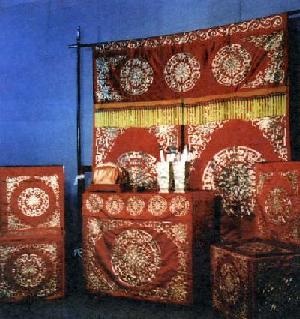Qimo(stage props) is the name for all stage properties and some simple decorations. The term first occurred in the Jin Dynasty (265-420).Qimoincludes articles of everyday life such as candlesticks, lanterns, fans, handkerchiefs, brushes, paper, ink and ink slabs, tea sets and wine sets; sedan chairs, vehicle flags, oars and horse whips; weapons; and various articles to demonstrate environments, such as cloth backdrops to represent cities, curtains, flags, table curtains and chair covers. TraditionalQimoare not just imitations of real articles, but artistic articles in their own right.
 |
|
Tables and chairs are usually made of wood and painted in red. The different arrangement of them on stages indicates different location and environment. One table with two chairs put on the stage before the performers appear is generic furnishings. For instance, the table is an imperial desk when the emperor inspects the court, a judge's desk when a county governor uses it to try a case, or a banquet table. The table can also be used as a rock or other objects. When a person goes up a hill, he stands on a table. One table on top of another means a particularly high mountain. The table can also represent a wall for jumping over. Slumping over a table with the head resting on one hand means to have a sleep. Climbing from a low hill to a higher one is represented by stepping from a chair onto a table. Chairs can be used to represent the doors of caves or jails.
 Others
Others
Flags are also frequently used on the stage. A square flag with the Chinese character for "marshal" on it, a rectangular flag with the Chinese character for "commander" on it and a flag with the name of a certain army on it represent the location of army camps and commanders-in-chief. In addition, there are water, fire, wind and vehicle flags. Actors shake these flags to represent waves, fire, wind or moving vehicles.
Waving a whip means riding a horse, and waving an oar means rowing a boat.
